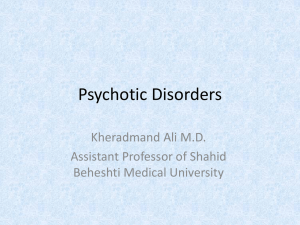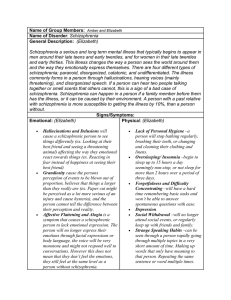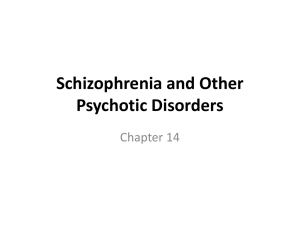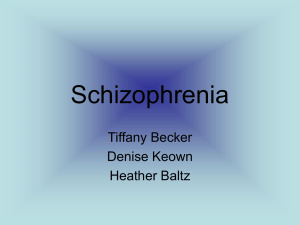Schizophrenia - Heather Culligan's Eportfolio
advertisement
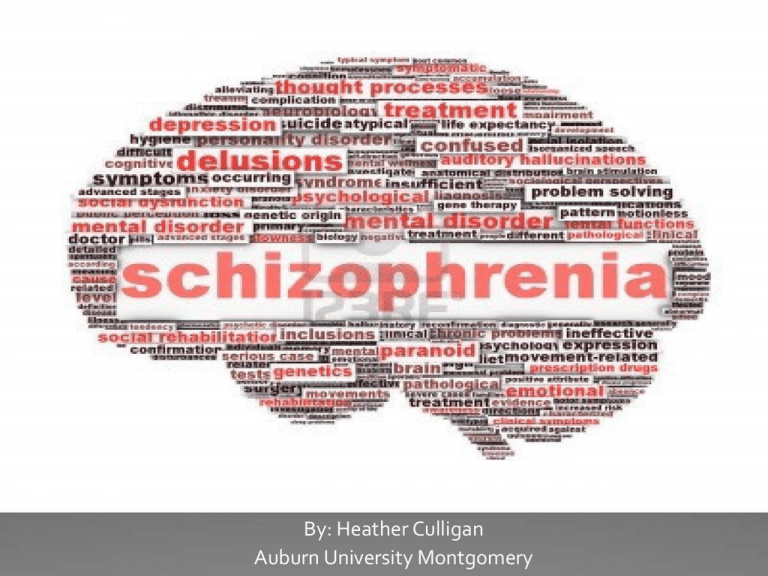
By: Heather Culligan Auburn University Montgomery “Schizophrenia is a group of severe brain disorders in which people interpret reality abnormally.” – Mayo Clinic MAKE SURE YOUR VOLUME IS TURNED UP Taken from reference 2 Schizophrenia is described as over activity of dopaminergic pathways in the basal nuclei, an area of the brain that controls motor activity. This means that the persons receptors in their brain are not firing correctly which causes the person to hear voices that are not there or see things that are not there. Also, MRI studies show abnormalities in the neocortical and limbic regions and interconnecting white matter tracts of the brain. Studies have found that 2 networks of white matter tracts are reduced in Schizophrenia. The purpose of this picture is to show you how little control schizophrenia people have over their actions. Family history of Schizophrenia Exposure to viruses, toxins or malnutrition while in the womb. Older paternal age. Taking psychoactive drugs during adolescence and young adulthood. Stressful life circumstances. Taken from Reference 1 Hallucinations (hearing voices) Delusions Paranoia Disordered thinking Distorted perceptions of Reality Flat affect Strange behavior such as communicating in rambling statements or made up words. Social Withdrawal Loss of motivation and interest in everyday activates. http://www.youtube.com/watch?v=KBRAC4acr70&f eature=endscreen&NR=1 There are no DIAGNOSTIC TESTS for Schizophrenia with that being said a doctor may draw some blood or do other basic tests to rule out other illnesses. To be diagnosed with Schizophrenia a person must meet a criteria in the Diagnostic and Statistical Manual of Mental Disorders (DSM). 1. A person must have at least two of the common symptoms of the disorder. delusions, hallucinations, disorganized speech, disorganized or catatonic behavior for a significant amount of time during one month. 2. Experience significant impairment in the ability to work, attend school or perform normal daily tasks. 3. Have had symptoms for at least six months.(1) Taken from Reference 3 Is there a Cure? There is no cure for Schizophrenia but there are Treatment options to control the manifestations of the disease. There are many different medications offered for treatment. One type of drug offered is called Phenothiazines. Examples of this type of drug are chlorpromazine, fluphenazine, perphenazine, compazine, mellaril, trifluoperazine. This drug works by providing symptomatic relief of positive symptoms and controls manic symptoms. Another type of drug that can be used is called Conventional Nonphenothiazine Antipsychotics. Examples are Haldol, Loxapine, pimozide, thiothixene. The way these drug work are similar to the above drug type except the incidence of sedation and anticholinergic adverse effects are less. The 3rd type of drug is called Atypical Antipsychotics. Examples are Abilify, Saphris, Clozaril, Fanapt, Latuda, Zyprexa, Invega, Seroquel, Risperdal, Geodon. This type of medication are the most common ones used today. Atypical drugs treat both positive and negative symptoms of schizophrenia. Taken from Reference 4 Evidence Based The most common treatment modalities according to our book Pathopharmacology for Nurses are the Atypical Antipsychotics. “ In 2002 a newer drug class was developed to better meet the needs of patients with psychoses. . . This class is called the dopamine system stabilizers, because it controls both positive and negative symptoms of schizophrenia it is grouped with atypical antipsychotics (p.219).” It is well tolerated by patients and has less symptoms. The name of this drug is Abilify. Taken from reference 4. References 1. Frankenburg, R.(2013). Schizoprenia. Medscape. from http://emedicine.medscape.com/article/288259overview#aw2aab6b2b2. 2. Bengston, M. (2006). Types of Schizophrenia. Psych Central. Retrieved on July 18, 2013, from http://psychcentral.com/lib/typesof-schizophrenia/000714. 3. Mayo Clinic. (2012). Schizophrenia. Mayo Clinic. Retrieved fromhttp://www.mayoclinic.com/health/schizophrenia/DS00196. 4. Adams, M.P, & Holland, L.N, & Urban, C.Q.(2011). Pharmacology for Nurses: A Pathophysiologic Approach.(4th ed.). Boston. Pearson. (p. 210-219).




